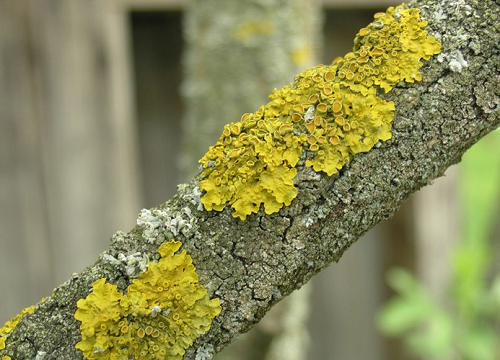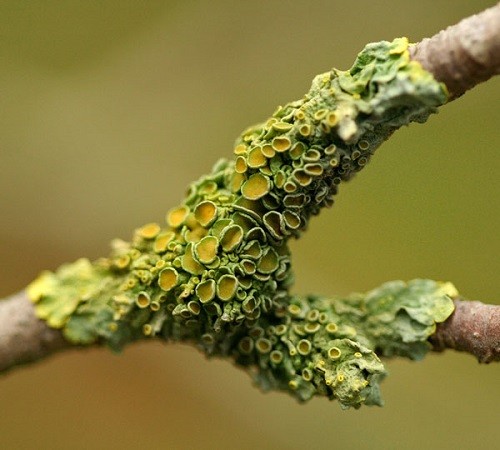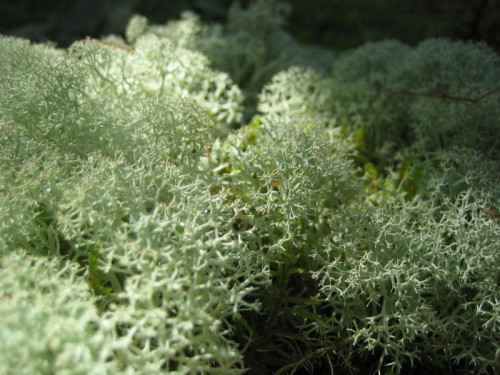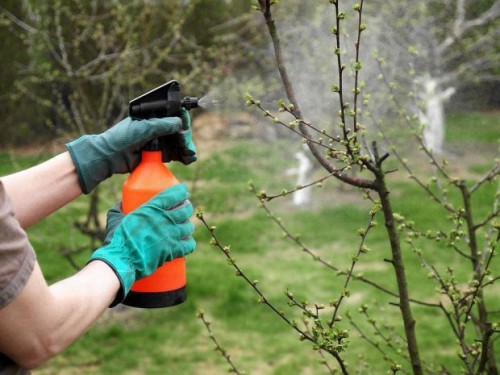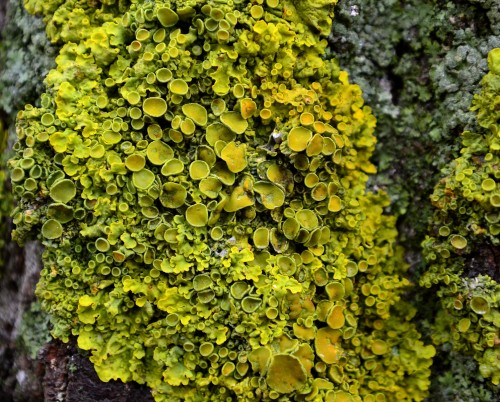It has been proven that fruit trees covered with highlights of lichens or moss bring a less rich harvest and die much earlier than the deadline. Instant plants create a favorable medium for breeding insects, which also negatively affect the growth of trees. How dangerous mosses and lichens are dangerous on the tree, and how to fight lichens, read in this article.
Content
Plant characteristics
Infection of trees with lichens and mkhami mistakenly bind to the old age of plants. In fact, the presence of growths indicates a weakened immunity of fruit trees and an unfavorable environment.
Wrong the occurrence of lichens and moss can frozen and cracking codes, too thick kroon, creating an excess shadow and preventing good ventilating, excessive watering and other factors.
It is impossible to say that lichens and mosses on trees are malicious parasitic species, but they can greatly harm the plant, especially if they grow abundantly. The growths prevent the natural breath of trees through the bark, so the trunks and branches must be cleaned.
What is lichen
Before you understand how to deal with a lichen on the trees, it is necessary to study its morphology and a power method. Lichens are very unusual creatures that combine the quality of plants, mushrooms and even algae. The lichen itself consists of a variety of intertwined mushroom filaments, as in the present mycelium. Algae processes are placed between these threads. Thus, a mutually beneficial union arises: the mushroom threads perform the roots of the roots, tightly clinging to the bark, stones or the ground, and algae form green organic covers, protecting against excessive evaporation of water.
At one tree, up to 25 types of lichens can grow, each of which is characterized by dimensions, shape and colors. Especially noticeable lichens become early in the spring, when there are no green foliage on the trees, and drops and rains feed the growths, giving them a brighter color against the dark crust.
Lichens absorb moisture with all its surface, so there is a sufficiently small rain, morning fog or dew. With a long drought, they dry, "preserving" their life functions, but do not die - the first rain will revive them. Even if the lichen is completely dry and reached into dust, after moisturizing, he will grow and develop again. The only serious threat to these plants is the lack of sunlight - without photosynthesis, organic compounds in the plant part will not be formed, and the lichen will die.
Lichens on trees (photo) are growing very slowly, and they do not depend on anyone and eat completely independently (not at the expense of a tree), so the conversations about their parasitic nature are very controversial. However, the obvious relationship between the state of the tree and the presence of lichens on it speaks about the opposite. With a more attentive study, the problem becomes obvious that the growths are not the cause of the disease, but only a symptom. If the tree is young and healthy, it is actively developing, the bark is quickly stretched, and there is no possibility to attach a slow-growing lichen. When the tree is ill or is located in the "advanced" age, the rates of its growth slow down significantly, and here the lichens come to the scene. When the bark tree or bush is in a "calm" condition, it can be easily attached to it.
If the tree is seriously infected with fungal diseases or destroyed from the inside insect pests, lichens occupy it very quickly, thereby telling the owner of the garden that the plant requires urgent treatment or destruction. The "frozen" dying bark of lichens in just a couple of years can be covered with a dense impermeable case, which will lead to a speedy dying of the tree. Removal of growths in this case can only extend the life of the plant for several years. But the fact that lichens feel perfectly in dead wood and even stones indicate their non-parasitic nature.
The mass development of lichens signals an old age or disease of the tree, on which they grow, therefore, in some cases, one removal from the crust will not be enough - the tree from mushrooms or insects should be treated (true causes of the disease). In any case, extensive growths should be removed so that the lichens do not flood the entire garden.
Moss on trees
The second actual problem of many gardeners is moss on trees. Mossi, unlike lichen, love water very much and cannot grow in the sun, so they appear where the constant shadow and increased humidity appear. If these two simple conditions are met, the whole garden can quickly inflate moss, pushing the lawn and beneficial plants.
The main advantage of Makhov is that they do not have roots - they are replaced by filamentous processes that cling to the surface and absorb water. Machum reproduction occurs during periods of strong humidity - protracted rains, abundant dew, fog, excessive watering. After fertilization in a year they grow and ripen the boxes with disputes, which, falling into the ground, immediately germinate and allow their filamentous processes. It follows from this that the moss covers the area suitable for it is much faster than lichen.
Very often moss are bred in decorative purposes - to decorate the garden of stones, for example. What to say, some species are very beautiful and able to transform the landscape. But when they appear on the trees, where they are not at all place, you should immediately beat the alarm. The presence of at least a small moss outflow indicates that the soil in this place is too much moistened, the acidity is increased, and the crown of the tree needs thinning.
The rapid spread of the MPA interferes with the development of healthy shrubs and fruit trees. They can even displace the decorative lawn in just a year or two. All plants covered with dense moss cover, quickly die from lack of light and moisture.
Even if the moss was discovered on a tree branch high above the ground, he should not move anything to the lawn - the disputes will fall to the ground and germinate. The garden overgrown with moss very quickly fears. Such a dense "carpet" does not give moisture to evaporate from the ground, it will be overwhelmed, over time, a more moisture and dangerous look - Moss Sfagnum (White Moss) comes to replace the green mham. It actively accumulates moisture, which leads to the formation of peat swamps.
How to deal with moss and lichen
Mossi and lichens on fruit trees can be found in any abandoned or poorly well-kept garden. And at least these plants are not parasitic, their presence serves as a clear signal to the owners, that it is time to change the way to care for its plot.
Lichens appear at the bottom of the tree and gradually make their way up until they reach the highest branches to gain access to the sun. The yield of the tree every year is becoming less and less while it does not die from the lack of oxygen. The bark is stumbling, deformed, bursting during the winter frosts, mushrooms fall into "wounds", insects will fall, and as a result you get a set of problems, solve that can be solved only by cutting down a tree. There are several ways to get rid of a lichen on fruit trees, each of which we will look at in all details.
Mechanical method
For sufficient young trees with smooth bore, a mechanical way of fighting lichens and mkami is suitable. It is necessary to scrape from the surface of the crust all the growths. For this, a kapron brush is used or a wooden scraper (you can simply use a wooden kitchen blade or pointed chip). In no case do not use the usual metal spatula and the more the knife so as not to damage the wood.
Properly conducted delicate cleaning of the tree not only eliminates him from lichen, but also "rejuvenates" him. As a result, the yield, the quality of fruits and life of the plant increases.
But it is not enough to simply remove the growths from the bark, it is necessary to make disinfection of damaged areas to destroy small pieces of lichen in hard-to-reach places and minimize the possibility of recurrence. To make a solution, mix 5% iron vigor with 50 liters of water and sprinkle the barrel and tree branches.
The scraped moss and the lichen should not be left on the ground, because if favorable conditions are created there, the plants will take place and will "terrorize" shrubs or lawn, creating new problems.
Chemical method
The fight against lichens on fruit trees will be more efficient if you reinforce the effect of mechanical cleaning with a special decoction. This folk remedy for trees is used by experienced gardeners for many decades. His main advantages are accessibility and low cost, simplicity in preparation and high efficiency. At the same time, a prepared decoction, unlike purchased chemicals to combat pests, does not affect the quality and chemical composition of the crop. Moreover, it helps to remove not only moss and lichen on the tree cortex, but even get rid of ticks.
To prepare a decoction in 0.5 liters of boiling water, dissolve 600 g of gaised lime and put on a slow fire. Constantly stirring, slowly enter into a solution of 400 g of sulfur and pour another 1.5 liter of water. Stir to a homogeneous state and continue to boil 15 minutes. With a closed lid.
In the process of heating, the sulfur will enter the chemical response with lime, resulting in a red broth, against which no tick, fungus, lichen or moss.
Give the brave to cool to a temperature of 37-40C, break into a glass or plastic storage container. This is a strongly concentrated solution, which is enough for the processing of a large number of trees. In front of the spraying, spread 100 ml of ragger in 5 liters of water. It is recommended to breed so much ragger as you can use 1 time - diluted with water composition quickly becomes useless, decaying in the air.
Important: The decoction is poisonous not only for parasites and plants, but can harm both a person. Before overflowing or breed the composition, put on rubber gloves and safety glasses. It is recommended to store the decoction in hermetically closed container. Before cloging a bottle or jar, pour a small amount of machine oil along the wall of the capacitance - it will block access to oxygen and will not give it to oxidize.
Prevention of moss and lichen
If you do not want to wait for the moment when moss or lichen appears in your garden, preventive measures can be taken. To do this, you will need a copper vigor. Apple tree and pears are treated with a concentrated solution in proportion 1:20, plums and cherries like a less rich composition in a ratio of 1:30.
Copper cunery very quickly dries all kinds of lichen and moss, not allowing them to multiply and grow in trees.
Each autumn and in the spring are used to bleaching trunks, as well as skeletal branches of fruit trees. In the spring, the whirlwinds are needed not so much to protect against lichens, but in order not to give an accelerant after winter hibernate insects to pounce on a juicy wet bark. To make a solution, mix 150 g of copper sulfate with 10 liters of water and 3 kg of oversized lime.
Useful advice: Experienced gardeners do not recommend processing the trunks of young trees with a smooth bark with this solution, since it closes the pores, resulting in an oxygen exchange, and the strab thickens much slower.
Of all the foregoing it becomes clear that the lichen on the trunk of the tree is not a fatal ailment, but the "first call" is the fact that the gardening is carried out incorrectly. A real threat is brought only to strongly stained lichens and mosses, so it should be regularly bypassing the garden and pay attention to each change in the appearance of the crust. Finally, an interesting fact: lichens perform a specific protective function for an apple tree, not allowing the opportunity to settle so dangerous fungi, for example, black cancer.


